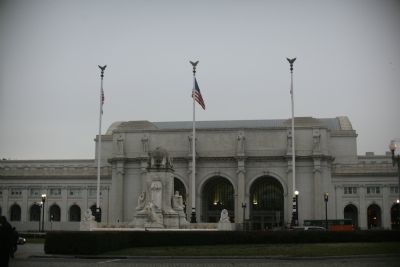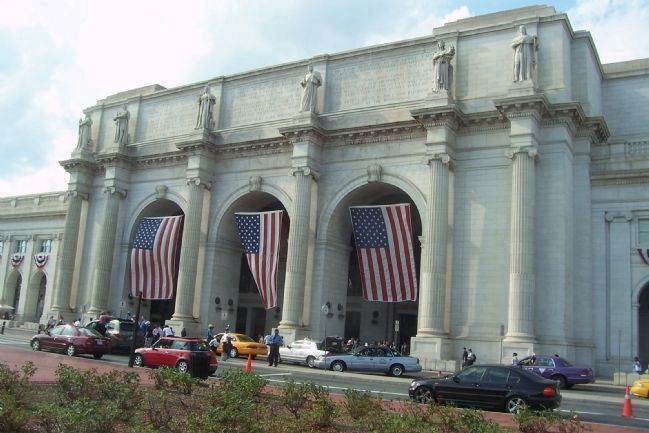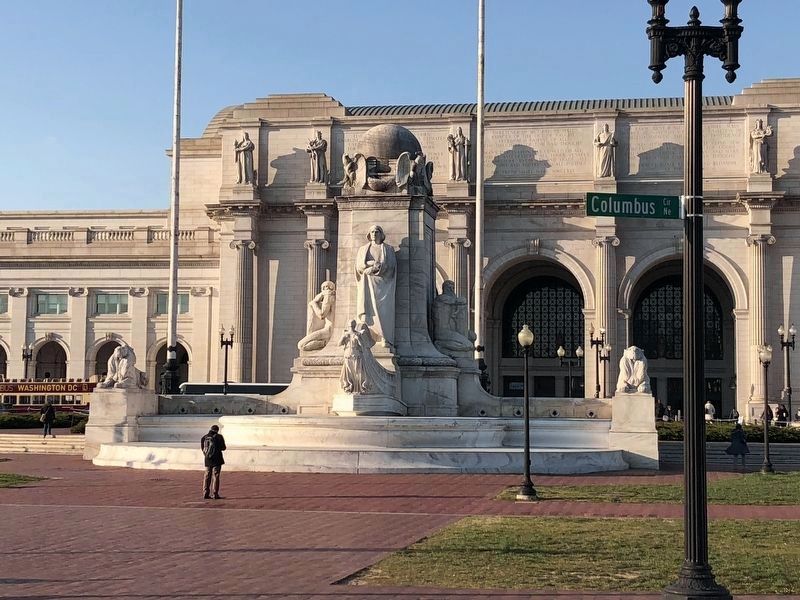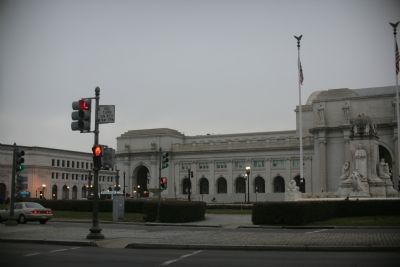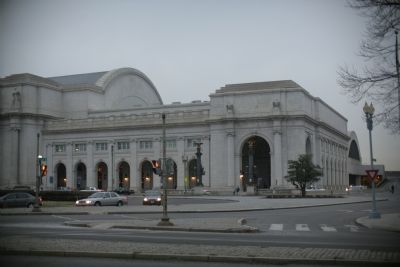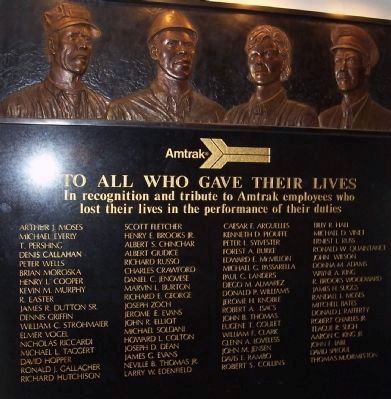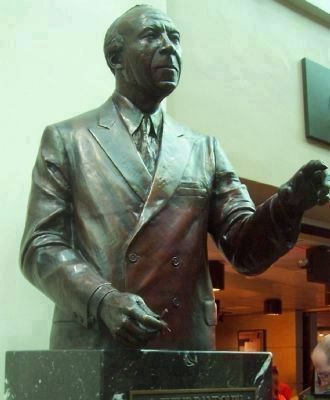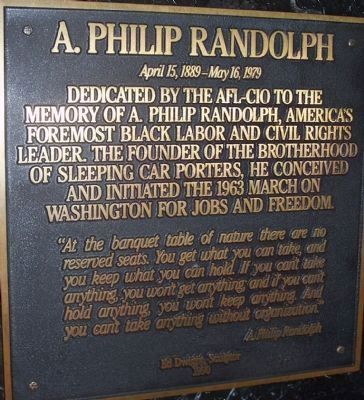Capitol Hill in Northeast Washington in Washington, District of Columbia — The American Northeast (Mid-Atlantic)
Delaware Avenue & Columbus Circle, NE
Historical Information
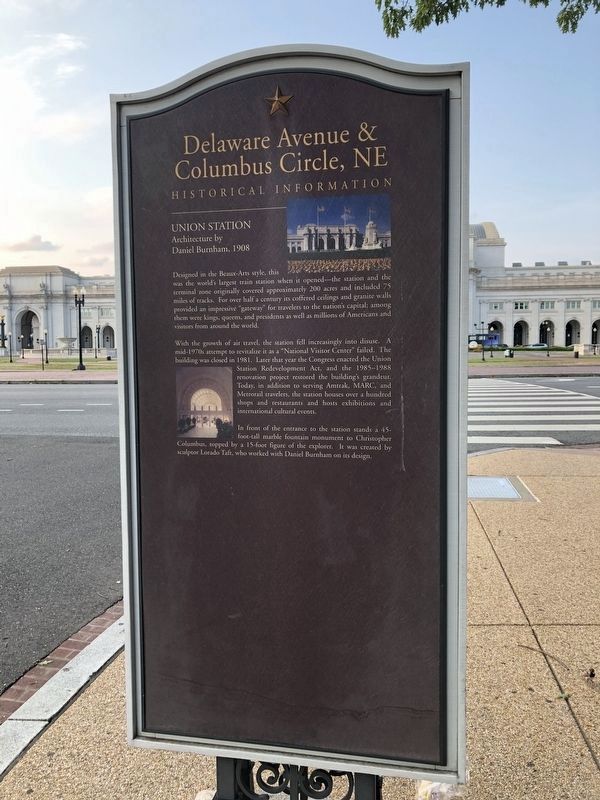
Photographed By Devry Becker Jones (CC0), July 16, 2020
1. Delaware Avenue & Columbus Circle, NE Marker
Union Station
Architecture by
Daniel Burnham, 1908
Designed in the Beaux-Arts style, this was the world's largest train station when it opened - the station and terminal zone originally covered approximately 200 acres and included 75 miles of tracks. For over half a century its coffered ceilings and granite walls provided an impressive “gateway” for travelers to the nation’s capital; among them were kings, queens, and presidents as well as millions of Americans and visitors from around the world.
With the growth of air travel, the station fell increasingly into disuse. A mid-1970’s attempt to revitalize it as a “National Visitor Center” failed. The building was closed in 1981. Later that year the Congress enacted the Union Station Redevelopment Act, and the 1985 - 1988 renovation project restored the building’s grandeur. Today, in addition to serving Amtrak, MARC and Metrorail travellers, the station houses over a hundred shops and restaurants and hosts exhibitions and international cultural events.
In front of the entrance to the station stands a 45-foot-tall marble fountain monument to Christopher Columbus, topped by a 15-foot figure of the explorer. It was created by sculptor Lorado Taft, who worked with Daniel Burnham on its design.
Topics and series. This historical marker is listed in these topic lists: Architecture • Railroads & Streetcars. In addition, it is included in the Former U.S. Presidents: #20 James A. Garfield, and the Pennsylvania Railroad (PRR) series lists. A significant historical year for this entry is 1981.
Location. 38° 53.743′ N, 77° 0.404′ W. Marker is in Northeast Washington in Washington, District of Columbia. It is in Capitol Hill. Marker is at the intersection of Columbus Circle Northeast and Delaware Avenue Northeast, on the right when traveling east on Columbus Circle Northeast. Touch for map. Marker is at or near this postal address: 50 Massachusetts Avenue Northeast, Washington DC 20002, United States of America. Touch for directions.
Other nearby markers. At least 8 other markers are within walking distance of this marker. Christopher Columbus (within shouting distance of this marker); “The President’s Trees” (about 300 feet away, measured in a direct line); The Freedom Bell (about 300 feet away); Gateway to The Nation's Capital (about 700 feet away); Famine-Genocide in Ukraine (approx. 0.2 miles away); Swampoodle (approx. 0.2 miles away); Here were the lots acquired on October 3, 1798
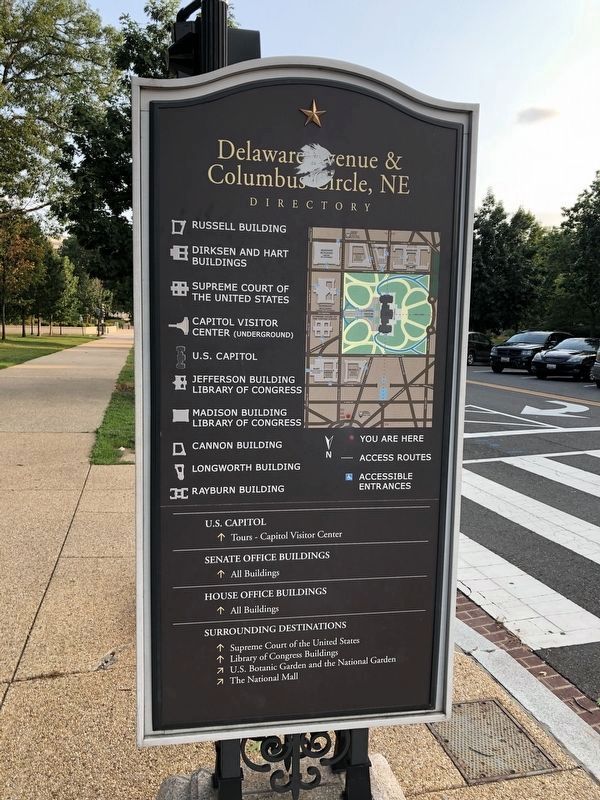
Photographed By Devry Becker Jones (CC0), July 16, 2020
2. Delaware Avenue & Columbus Circle, NE Marker
Regarding Delaware Avenue & Columbus Circle, NE.
1. Books about Union Station include;
Highsmith, Carol M. and Landphair, Ted (1988) Union Station A Decorative History of Washington's Grand Terminal. (Chelsea Publishing, Washington)
Highsmith, Carol M. and Landphair, Ted (1998) Union Station A History of Washington's Grand Terminal (Union Station Venture, Washington)
2. Additional background
Washington's Union Station replaced two railroad terminals that had been built in the District of Columbia. One was Sixth Street Station, which was operated by the Baltimore and Potomac Railroad (a predecessor of the Pennsylvania Railroad). The other was New Jersey Avenue Station, which was operated by the Baltimore and Ohio Railroad.
There were several reasons to build this grand structure. One was to enhance presidential security. James Garfield had been assassinated in one of the nearby stations. There is (or was) a room in Union Station whose sole function was to give Presidents
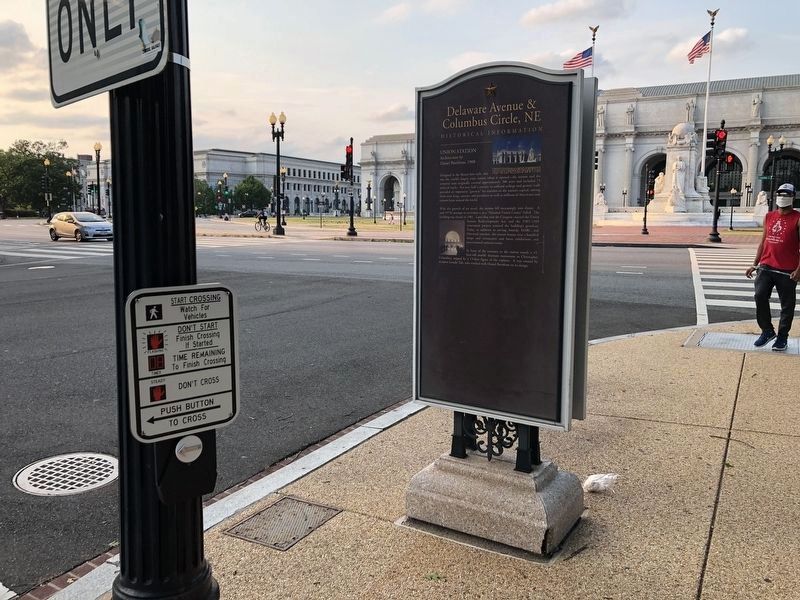
Photographed By Devry Becker Jones (CC0), July 16, 2020
3. Delaware Avenue & Columbus Circle, NE Marker
Washington's Union Station was for a time owned and operated by a corporation called The Washington Terminal Company. This corporation was jointly owned by both the Pennsylvania Railroad and the Baltimore and Ohio Railroad. Amtrak eventually became the owner of the Washington Terminal Company and merged with it. The Washington Terminal Company had several unique and interesting locomotives. One was an electrically powered MP-54 "Owl Car." The MP-54 was used to shuttle employees between the station and nearby Ivy City locomotive maintenance facility. Another was the switching locomotive nicknamed the "Quarter Horse." This switcher was built by a company called FAUR and is headquartered in Bucharest,
Romania. Both the "Owl Car" and the "Quarter Horse" were retired years ago.
Union Station has hosted several demonstrations of special modern railroad equipment. One of them was the LRC (Light Rapid Comfortable) train, which this intrepid editor rode between Union Station DC and Odenton MD. Another was the JetTrain turbine locomotive in October 2002. The prototype was built by Bombardier and is capable of 150 miles per hour. JetTrain was proposed to be an element of the Florida Overland Express high speed rail plan. Funding for the system was denied by a referendum in 2004.
Also see . . .
1. Union Station: A Decorative History of Washington’s Grand Terminal. 1988 book by Carol Highsmith and Ted Landphair on Amazon.com. (Submitted on April 4, 2008, by Tom Fuchs of Greenbelt, Maryland.)
2. Union Station: A history of Washington’s grand terminal. 2nd Edition. 1998 book by Carol M. Highsmith on Amazon.com (Submitted on April 4, 2008, by Tom Fuchs of Greenbelt, Maryland.)
Additional commentary.
1. W. Graham Claytor, Jr.
Transcript of text on plaque shown on photo No. 9.
W. Graham Claytor, Jr., President and Chairman, National Railroad Passenger Corporation (Amtrak), July 3, 1982–December 6, 1993.
Following a long and distinguished career in public service and private industry, W. Graham Claytor, Jr. brought to Amtrak a life-log love of passenger trains and a dedication to the quality of rail passenger service. Among his most significant achievements at Amtrak was his leadership in the formation of a public-private partnership to restore and redevelop Washington Union Station.
In recognition of this service to intercity and commuter rail passengers, the community and its visitors; and in recognition of his nearly sixty years of public service, spanning eleven U.S. presidencies, and his many contributions to the American people through a remarkable career of business, military and government service, on January 26, 1994, by resolution of the Board of Directors of the National Railroad Passenger Corporation, the Washington Union Station train concourse was named the “Claytor Concourse.”
— Submitted June 29, 2008.
2. A. Philip Randolph
Transcript of text on plaque affixed to the statue of A. Philip Randolph shown in Photo No. 12.
A. Philip Randolph, April 15, 1889–May 16, 1979.
Dedicated by the AFL-CIO to the memory of A. Philip Randolph, America’s foremost black labor and civil rights leader. The founder of the Brotherhood of Sleeping Car Porters, he conceived and initiated the 1963 March on Washington for jobs and freedom.
“At the banquet table of nature there are no reserved
— Submitted June 29, 2008.
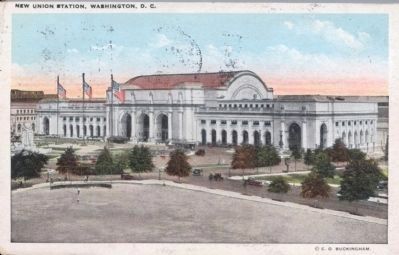
J. J. Prats Postcard Collection
9. Circa 1927 Postcard “New Union Station, Washington, D. C.”
Caption on back “The new Union Station was built by the U. S. Government and the Pennsylvania Railroad and the Baltimore and Ohio Railroad. The cost of the land, building and terminal improvements was $18,000,000. The structure is the finest railway station in the world. The building, of white granite, is 760 feet in length and 343 feet in width.” Published by the Union News Company.
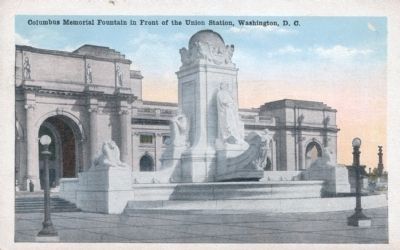
J. J. Prats Postcard Collection
10. Columbus Memorial Fountain in Front of the Union Station, Washington, D. C.
Circa 1917 postcard has this caption on back: “The Columbus Memorial Fountain, Washington, D. C., is situated on the Union Station Plaza. It is semi-circular in form, seventy feet wide and sixty-five feet deep. A shaft forty-five feet high surmounted by a globe borne by four eagles form the background for the statue of Columbus, who is represented as standing on the prow of a ship, the figure-head of which is a beautiful female figure typifying ‘The Spirit of Discovery.’ On the left of the shaft is the figure of an Indian portraying the New World, and on the right side of the figure of a patriarchal Caucasian representing the Old World, while the rear of the shaft carries a medallion representing Ferdinand and Isabella of Spain. The extreme ends are flanked by two enormous lions. Dedicated June the 8th 1912. Sculptor, Lorado Taft; Cost 100,000.” Published by W. B. Garrison, Inc., Washington D.C.
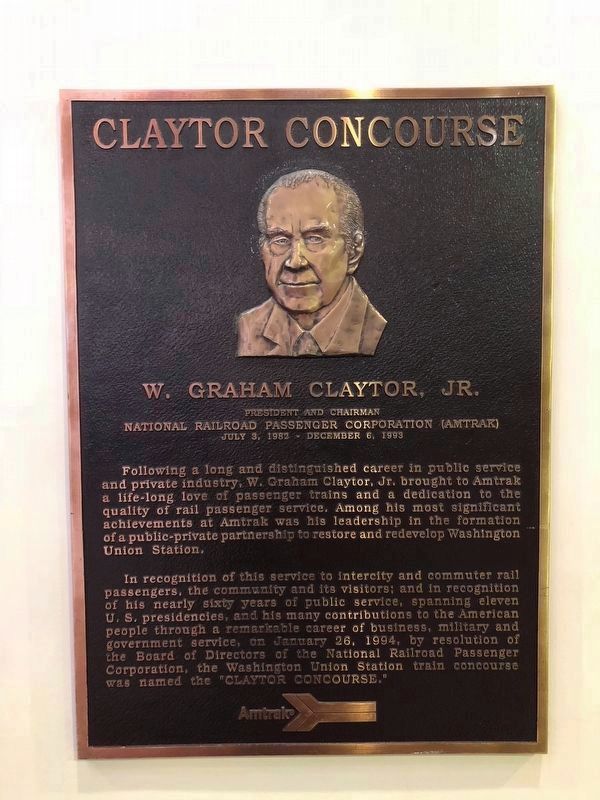
Photographed By Devry Becker Jones (CC0)
12. Claytor Concourse
Interior marker plaque dedicating the Amtrak concourse to the corporation's president and chairman for his leadership in restoring and renovating Union Station, 1994.
Credits. This page was last revised on January 30, 2023. It was originally submitted on January 22, 2008, by Tom Fuchs of Greenbelt, Maryland. This page has been viewed 4,879 times since then and 55 times this year. Last updated on June 20, 2008, by Richard E. Miller of Oxon Hill, Maryland. Photos: 1, 2, 3. submitted on July 16, 2020, by Devry Becker Jones of Washington, District of Columbia. 4. submitted on January 22, 2008, by Tom Fuchs of Greenbelt, Maryland. 5. submitted on June 28, 2008, by Richard E. Miller of Oxon Hill, Maryland. 6. submitted on April 10, 2018, by Devry Becker Jones of Washington, District of Columbia. 7, 8. submitted on January 22, 2008, by Tom Fuchs of Greenbelt, Maryland. 9, 10. submitted on September 28, 2008, by J. J. Prats of Powell, Ohio. 11. submitted on June 28, 2008, by Richard E. Miller of Oxon Hill, Maryland. 12. submitted on April 6, 2018, by Devry Becker Jones of Washington, District of Columbia. 13, 14. submitted on June 28, 2008, by Richard E. Miller of Oxon Hill, Maryland. • J. J. Prats was the editor who published this page.
